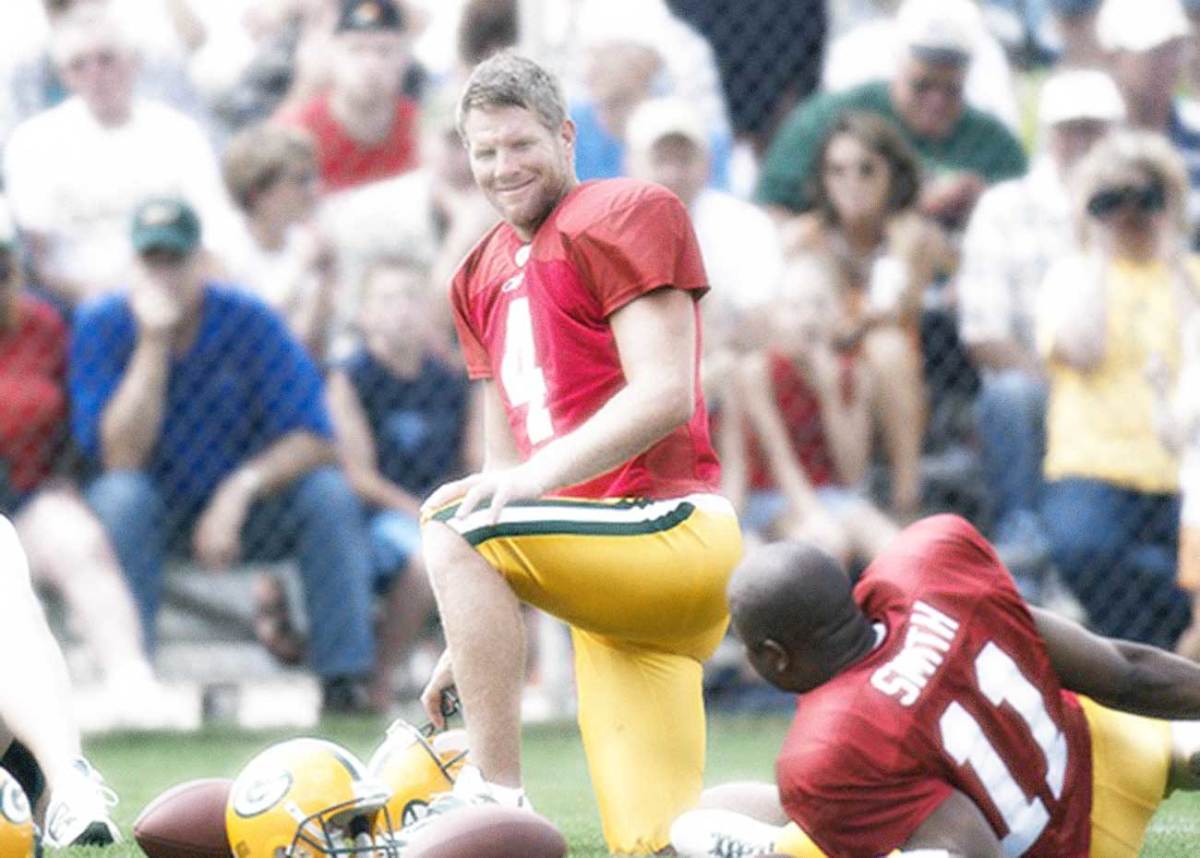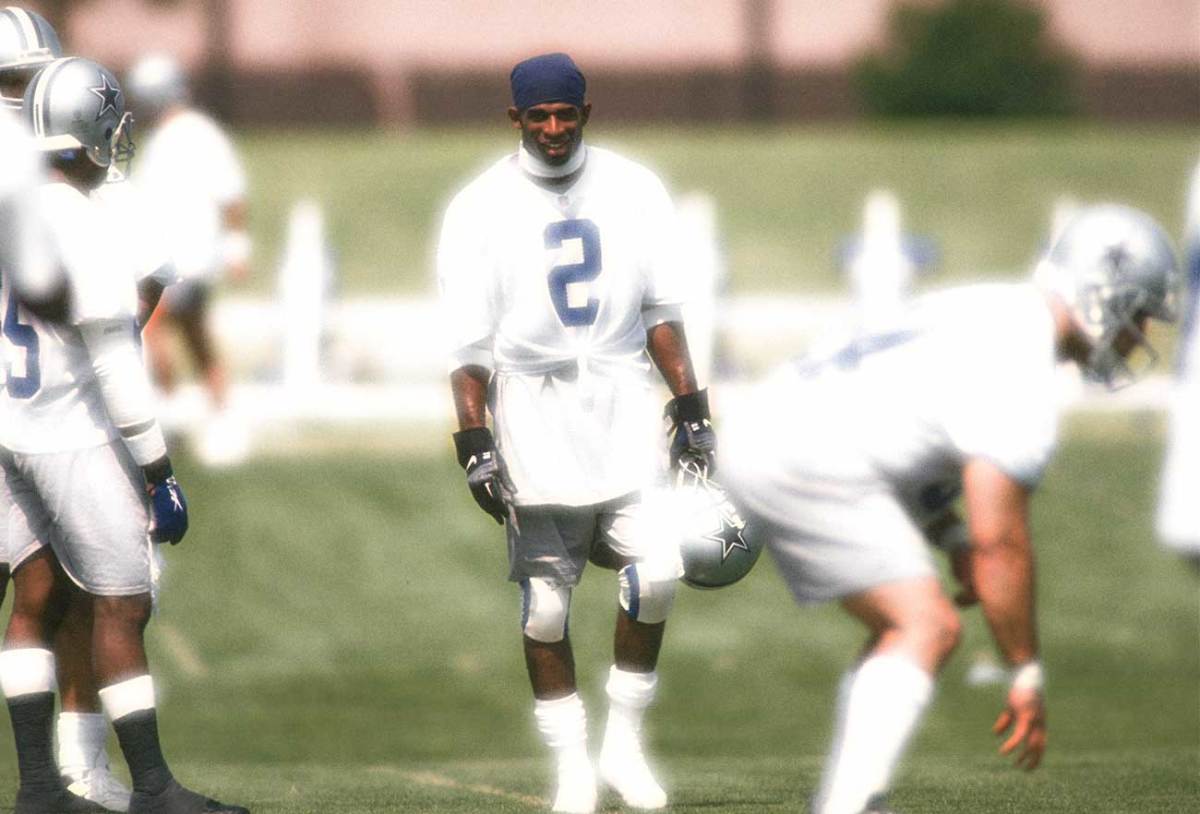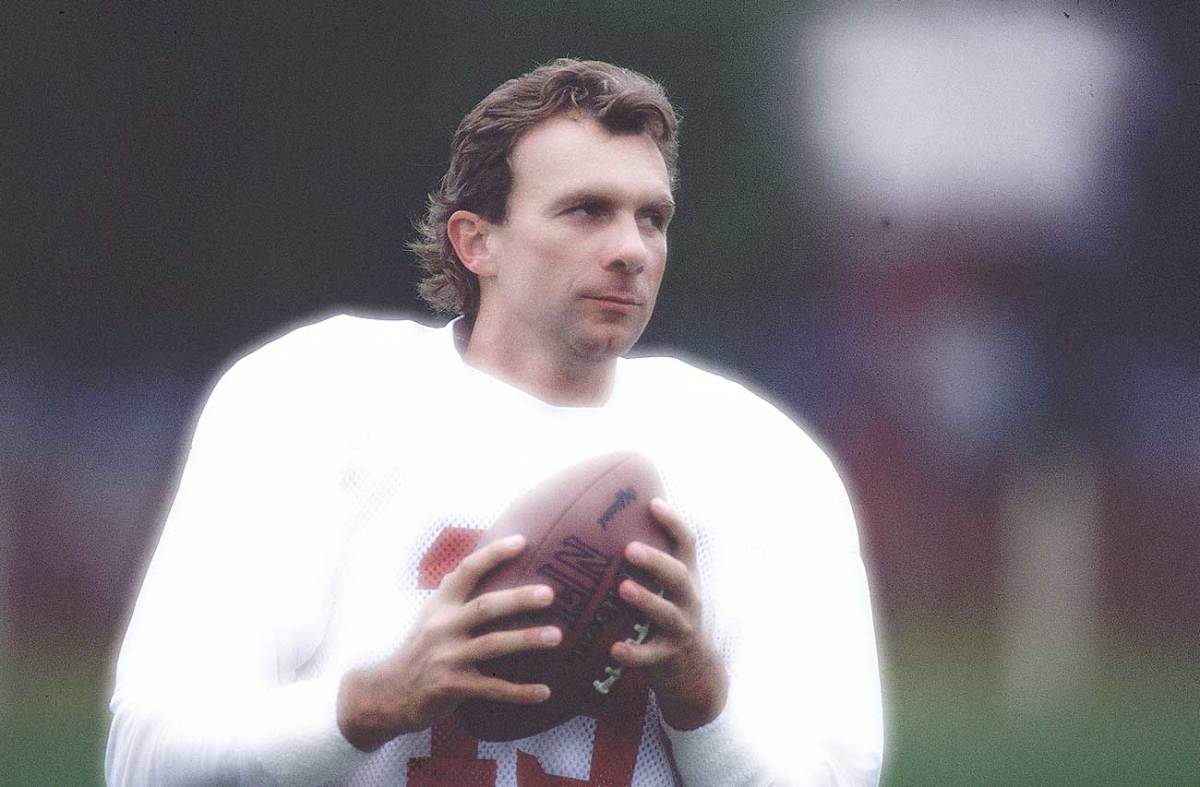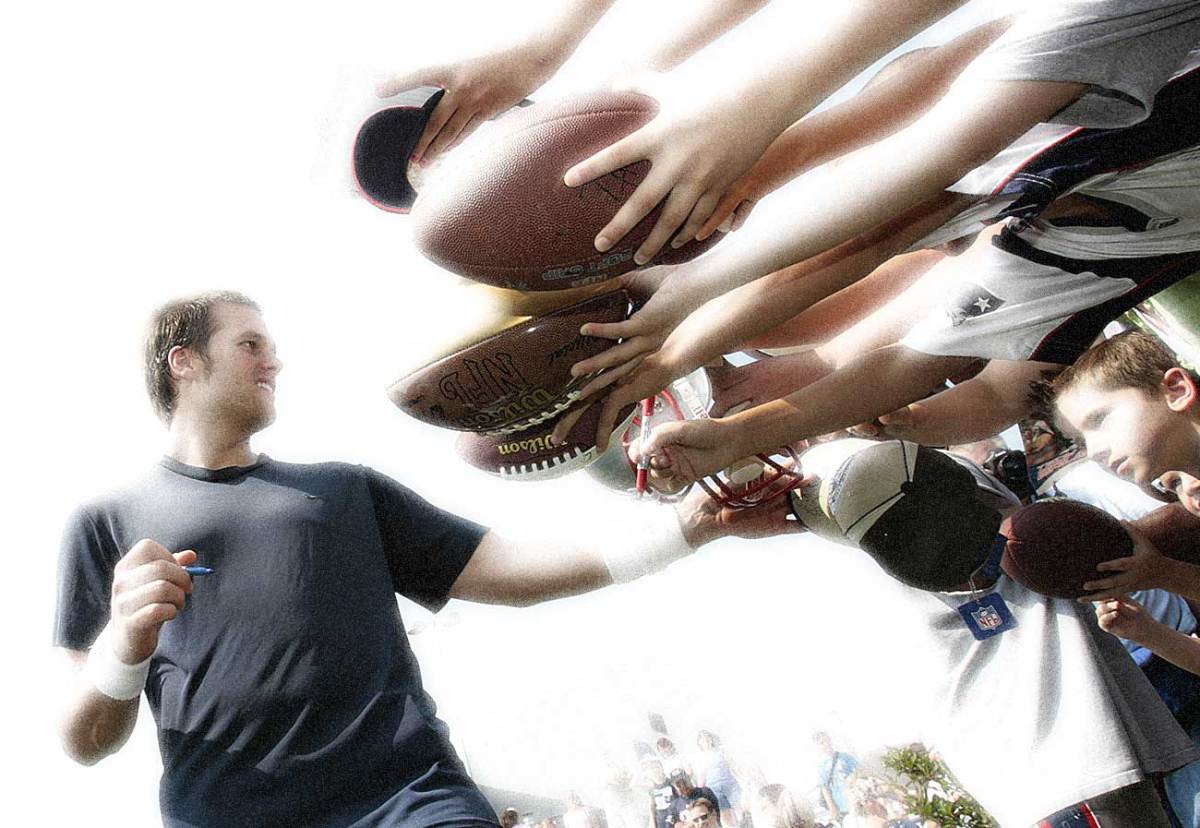The MMQB All-Time NFL Draft: The Ultimate Football Fantasy

On a steaming, northern Midwestern July morning, Vince Lombardi moves through the middle of a complex of practice football fields at St. Norbert College in De Pere, Wis. Grumpily eschewing the fancy, breathable outfit left in his locker that morning by a shoe-and-apparel company representative, Lombardi is wearing wrinkled, pale-yellow football pants and a white T-shirt, with a weathered baseball cap shading his tanned face. On his feet are low-cut black leather football cleats and white socks pulled up to mid-calf. This is roughly the same outfit Lombardi wore when he brought his first Packers team to camp in the summer of 1959, the launching pad for one of the great and most iconic dynasties in NFL history. The campus lies six miles south of Lambeau Field, where nearly 50 years ago Lombardi exulted on the sideline when his quarterback, Bart Starr, sneaked across the goal line to beat the Cowboys in the Ice Bowl, played in minus-15° temperatures. It seems impossibly distant today, not only for the passage of time but also because the mercury is pushing 90°, and it’s not yet noon.
Lombardi is back now to helm the as-yet-unnamed team chosen by its general manager and team president, longtime NFL executive Ernie Accorsi, in the first MMQB All-Time NFL Draft. The project, the brainchild of MMQB founder Peter King and executive editor Mark Mravic, created a league of 12 dream teams that would feature many of the greatest names across the spectrum of NFL history. King and 11 other GMs—former league executives, players, football writers and historians—assembled on a conference call in May to draft rosters of 25 players each, constrained only by their imaginations and their peers’ previous selections. After their player lists were set, GMs picked coaches. Lombardi, who was taken first, had his final season in Green Bay in 1967; he led the Packers to five NFL titles in nine years and won the first two Super Bowls. Lombardi also coached the Redskins in ’69.
Early in this practice Lombardi jumps on the front of a five-man blocking sled, a relic from an earlier time that he insisted be delivered from the Pro Football Hall of Fame in Canton to his facility. Lombardi has always been at home on a sled, exhorting his linemen; he was a guard himself, one of the Seven Blocks of Granite at Fordham in 1936. Here he is looking to install a version of his Packers power sweep, which utilized early zone-blocking principles. Lombardi has a terrific line, including modern-day Hall of Famers Willie Roaf at left tackle and Russ Grimm at right guard. But the coach is -really excited about his center, Clyde (Bulldog) Turner, an ornery cuss out of Plains, Texas, and Hardin-Simmons College, who played center and linebacker for the Bears from 1940 through ’52. At 6' 1" and 237 pounds, Turner is exceptionally quick. “Coach Lombardi thinks I’ll be able to make that reach block on the sweep that Jim Ringo used to make,” says Turner, fiddling with his face mask, which he’s never worn and doesn’t like one little bit.

On an adjacent field, middle linebacker Ray Lewis has gathered the Lombardi-Accorsi defense in a circle and is gesticulating wildly, raising and lowering his voice as if preaching to a congregation. At the edge of the group, tackle Artie Donovan, a wisecracking, crewcut hell-raiser who played for the Colts in the 1950s, and Len Ford, a nimble, 6' 4", long-armed end for the Browns in that same era and among the first class of black players in the NFL, are visibly snickering. “Ray is the best damn tackler I’ve ever seen,” says Donovan. “But that young man talks up a storm.”
The MMQB Draft has created the most stunning collection of professional talent in history, spread across 12 training camps from San Diego to Boston. The clashing of generations has been remarkable. Early one evening, a dusky haze falls over the fields at Rockwood Lodge—hard by the water north of Green Bay—where Curly Lambeau first pioneered the concept of a remote training camp, and where the Packers’ founder and first coach is training the team selected by another former league executive, Ron Wolf. During a special teams segment at the end of practice Sammy Baugh, a quarterback with the Redskins from 1937 through ’52 but also a record-setting punter, boots a high spiral into the gloaming. More than 60 yards away Deion Sanders gathers in the kick and launches upfield. Sanders drops 1970s Steel Curtain cornerback Mel Blount to his knees with a hesitation move that also leaves Raiders linebacker Ted (the Mad Stork) Hendricks with armfuls of summer air. Sanders darts to the sideline, a technicolor do-rag flapping from under the back of his helmet, and just as he begins high-stepping, one hand behind his helmet, 1970s Raiders wide receiver Cliff Branch, a near-world-class sprinter, roars up from behind and drags Neon Deion to the ground. The two men rise, eye each other like fighters at the bell, and then embrace enthusiastically.
Earlier in the same practice, quarterback Brett Favre had dropped a swing pass into Bronko Nagurski’s breadbasket with perfect touch. Nagurski is one of the game’s true legends, a 6' 2", 226-pound fullback and defensive tackle who, the story goes, once barreled into the end zone and pancaked a horse that had been stationed to control the crowd. Here Nagurski had turned upfield and rolled onto a collision course with middle linebacker Tommy Nobis, a snarling, red-haired wrecking machine who came out of Texas in 1966 and spent 11 seasons with the expansion Falcons. Both men are faster than either realizes, and their collision brings a gasp from their teammates. Defensive tackle Mean Joe Greene of the Steelers, the second player taken in the entire MMQB All-Time Draft (after Giants outside linebacker Lawrence Taylor), reaches down to help up Nobis. Mel Hein, the Giants’ iron man center-linebacker from 1931 through ’45, picks Nagurski up by his shoulder pads, as he did so many times during their heyday.
* * *

Things are not going quite so smoothly in San Diego. General manager/selector Dan Fouts has drafted a team heavy on onetime Chargers (seven of his 25 players, and he also took a punter, Ray Guy, with the fourth overall selection, the most controversial choice in the draft), and the squad will be coached by Don Coryell, a mad genius who set the NFL ablaze with his Air Coryell passing system in the 1970s and ’80s. Coryell was a quirky savant; he once put the trash in the back of his station wagon, but instead of leaving it at the bottom of the driveway, drove all the way to work and allowed the steaming rubbish to ferment all day in the car.
But here he is installing an updated version of Air Coryell with the help of a team of Silicon Valley software developers he flew in. Wide receivers Charlie Joiner and J.J. Jefferson and tight end Kellen Winslow—favorite targets of Fouts during their Chargers days—are picking up the new wrinkles, but this time the quarterback isn’t Fouts: It’s the early NFL version of Pittsburgh Hall of Famer Terry Bradshaw, who struggled with NFL complexity. The coach and the QB have butted heads, but when Coryell heard somebody whisper in a passing-game meeting, “I’m not sure he could spell cat if you spotted him the C and the A,” he leaped to Bradshaw’s defense. “Terry is as tough as Fouts, and he’s got a hell of an arm,” said Coryell. “Let’s give him a chance. Besides, we don’t have Joe Gilliam waiting on the sideline.”
Two of the MMQB Draft’s teams are training in Northern California. Longtime NFL senior vice president Joel Bussert’s club, coached by John Madden, is working out near the site of the El Rancho Tropicana Hotel, where Madden’s badass Raiders would “train” every summer. And south of there, in the punishing heat outside Sacramento, the team selected by John Wooten—a former Browns Pro Bowl guard and longtime chairman of The Fritz Pollard Alliance—and coached by Bill Walsh is training at Sierra College. This is where the 49ers went before winning their first Super Bowl in 1981 and stayed for 17 years.
At the Bussert camp on the El Rancho site, Madden has imbued his team with the spirit of the old Raiders. During one live scrimmage period there’s a palpable intensity from the defense. Middle linebacker Mike Singletary, who broke 16 helmets in his college career at Baylor and was the heart and soul of the Buddy Ryan Bears’ defense that ran roughshod over the NFL in 1985, is breathing steam from his nostrils, a frozen-tundra NFL Films moment that seems weird in July. To his left, on the edge of the defense, Taylor, the aforementioned top pick, is lunging forward and shouting, “Play like a pack of crazed dogs!”
In front of Taylor is right end Ed Sprinkle, who was raised poor in West Texas and played for the Bears from 1944 through ’55. Sprinkle, 6' 1" and 206 pounds, terrorized quarterbacks and ballcarriers with a vicious clothesline move he called “the claw.” Collier’s magazine called Sprinkle “the meanest man in football,” recalling that in the 1946 NFL title game, he knocked two players out of the game and broke the nose of a third with his trademark move. Here Sprinkle drops into a three-point stance and hears Taylor screaming about crazed dogs. “Not a problem, Lawrence,” says Sprinkle. “Not. A. Problem.”
Madden patrols the sideline in silver--colored polyester pants and an oversized black golf shirt, a signature outfit from his glory days. Watching his juiced defense, he shakes a fist. “Now that’s tough-actin’! We’re gonna get after people. BOOM!”
Over in Rocklin, Calif., the cerebral Walsh is running a more civilized camp. He created what came to be known as the West Coast offense when he was an assistant with the Bengals in 1968 and rode it to three Super Bowls with the 49ers in the ’80s. Here he has the quarterback of those teams, Joe Montana, and a group of versatile receivers to spread the field in a modernized version of the WCO: Art Monk, tight end Ozzie Newsome and wild-card receiver Isaac Bruce. But the wideout making the most noise is “Bullet” Bob Hayes, from the Cowboys of the ’60s and early ’70s.

Montana never had the strongest arm, and for several days he’s been under-throwing Hayes, the 1964 Olympic gold medalist in the 100‑meter dash who many track and field experts believe could challenge Jamaican super-star Usain Bolt with modern shoes and tracks. Hayes is certainly the fastest receiver in NFL history. Finally, late in one practice, he runs a deep go route, full speed, and Montana crow-hops two steps and heaves the ball with everything in his skinny right arm. The pass hangs over the field, impossibly deep, until at the last second Hayes, in his number 22 jersey and with his pigeon-toed stride, catches up to it, cradling the ball with a soft ffftt against his fingers.
Montana jogs toward the sideline and slaps hands with a portly blond man in a windbreaker, then comes back to the huddle. Leaning in to call the next play, Montana looks at his running backs, O.J. Simpson and Jim Thorpe, and says, “Hey, did you see who’s here? John Candy.”
Montana wasn’t the only quarterback experiencing underthrow issues. On the team selected by Pro Football Hall of Fame executive director Joe Horrigan and coached by Don Shula of the unbeaten 1972 Dolphins, who holds the record with 328 victories, quarterback Peyton Manning is struggling to cope with the breathtaking and efficient speed of wideout Don Hutson. The first receiver taken in this draft (No. 8, between Reggie White and Tom Brady), the 6' 1", 183-pound Hutson played for the Packers from 1935 to ’45 and caught 99 touchdown passes in those 11 seasons, stunning totals from a dead-ball era in which teams rarely threw on first or second down and often punted on third. Hutson glides like a mountain lion, low to the ground, and then rises to pluck passes from the air. Manning struggles to gauge his speed. “My gracious!” shouts Manning after one egregiously short throw. “Sakes alive!”
* * *
Generations mix enthusiastically, trading secrets and stories. At Fenway Park in Boston, a team selected by football historian John Turney is practicing under coach Bill Belichick. A voracious student of the game’s past, Belichick ensures that safeties Nolan Cromwell and Ed Reed are rooming together. Reed played against Belichick’s Patriots teams through the 2000s, and the coach has called him the best free safety in history. But Cromwell, a wishbone quarterback and near-Olympic-level 400-meter hurdler at Kansas in the 1970s, helped define the position of the modern, ball-hawking, hard-hitting safety with the Rams from ’77 to ’87. “We think Ed can learn from Nolan,” says Belichick. “And Nolan can learn from Ed.”
On the team picked by longtime NFL writer Bob McGinn, coach Joe Gibbs has put 26-year-old right guard Zack Martin of the Cowboys in the locker next to 1970s-era Steelers center Mike Webster, who played 17 years and was one of the groundbreaking cases of CTE. The two quietly trade words every day after practice. One day Webster was seen slowly examining his new helmet, looking at it inside and out, for several long minutes, as if wondering what might have been.
The Bill Polian–selected team is practicing at Kent State under co-coaches Marv Levy and Tony Dungy. Polian said he couldn’t choose between the two, who both worked for him in the NFL. He also couldn’t decide where to hold camp, in Buffalo or Indianapolis, so he chose a point in between. After a recent dawn practice, quarterback Otto Graham, the leader of the Browns from 1946 through ’55 and certainly the greatest quarterback of the pre-passing-game era, is working with Cris Carter, the ruthless wide receiving technician who caught 1,101 passes, mostly with the Vikings, from ’87 through 2002. Carter appears to be teaching Graham the back-shoulder throw. With each repeat, the passes are more accurate. Nearby, Barry Sanders, one of the most elusive ball-carriers in history, is doing a little dance with Earl Campbell, who never tried to make anybody miss. Sanders feints and jabs. Big Earl laughs so hard he drops to his knees.
Some of the practices have turned emotional. The team selected by longtime Dallas sportswriter Rick Gosselin and coached by the legendary Paul Brown is practicing, not at Hiram College, where the last of Brown’s Cleveland teams held training camp, but at the Browns’ modern facility in Berea, Ohio. “I wanted every advantage of the modern game,” says Brown. “Hiram was primitive.”
Brown’s quarterback is Johnny Unitas. Unlike his coach, he’s going old-school, with high-topped black cleats and a two-bar plastic face mask. One afternoon Unitas was carving up the defense with pinpoint throws, calling his own plays and moving up the field like it was the fourth quarter of the 1958 title game. A quick out to Lance (Bambi) Alworth, the lightning-fast receiver from the ’60s Chargers. A seam route to tight end Antonio Gates, another Charger from later days. Finally, a slant to Michael Irvin, after which the Playmaker spins the ball on the ground in front of middle linebacker Dick Butkus. In the defensive huddle Butkus implores his line to pressure Unitas, whose quick release is surgical. On the next snap, defensive end Deacon Jones stuns blocker Art Shell with a head slap, and 306-pound defensive tackle Gene (Big Daddy) Lipscomb, who played with Unitas from ’56 through ’60, charges through on a stunt and levels the quarterback. For a second there is silence, until Lipscomb hoists Unitas up with one, giant hand.
• PETER KING ON THE MMQB ALL-TIME NFL DRAFT: How it went down, and key takeaways
* * *

Yet the most intense practices are at St. Vincent College in Latrobe, Pa., where general manager Peter King’s team, coached by Chuck Noll, is staging daily slugfests. King’s secondary sets the tone every afternoon, with cornerbacks Lester Hayes of the 1970s and ’80s Raiders, slathered in Stickum, and Dick (Night Train) Lane of the ’60s Lions shutting down quarterback Tom Brady’s offense. Linebacker Jack Lambert, toothless and brooding, trades off calling the shots from the middle of Noll’s updated Cover 2 scheme, with Chuck Bednarik, who went both ways for the Eagles from 1949 through ’62 and is, indeed, going both ways here. Defensive ends J.J. Watt, of the Texans, and Carl Eller, of the ’70s Vikings’ Purple People Eaters, are relentless.
But then there comes a moment: Under withering pressure Brady drops a quick check-down to his running back in the left flat. From there the mercurial form of Gale Sayers flows across the defense in a series of blinding cutbacks. This is the Sayers of 1965 through ’67, the Kansas Comet whose slashing moves and breathtaking speed have only rarely been duplicated. Here Night Train flails at air attempting his lethal clothesline. Safety Troy Polamalu’s ankles are broken in space. Bednarik crashes into his Eagles’ evolutionary brother, strong safety Brian Dawkins, in a Keystone Kops moment as Sayers darts between them. Finally Sayers bursts into open space and races untouched to the goal line as Noll’s whistle pierces the still air. Brady screams, a high-pitched childlike squeal. “Yeah, baby,” he shouts. “You never saw Danny Woodhead make moves like that!”
Still, the moment of the week comes at Valley Ranch, outside Dallas, where Tom Landry is coaching the team assembled by his old Cowboys colleague, Gil Brandt. (In a gesture of goodwill Landry invited Jerry Jones, who fired him in 1989, a ham-handed move that ended a legendary career, though Landry insisted that Jones watch practices from a roped-off pen reserved for sportswriters.) Landry’s practices are seamlessly efficient, with an offense built around running backs Jim Brown, who retired after the 1965 season at age 29; and Walter Payton, who played 13 years with the Bears and surpassed Brown as the leading rusher in NFL history. A proud man, Brown dispenses praise very grudgingly. But he has bonded with Payton. In a goal line sequence, quarterback Troy Aikman fakes inside to Brown and then tosses wide to Payton, who walks in at the pylon. Payton holds the ball over his head as if to spike it, but instead hands the ball to Brown, who tosses it to the practice referee. The two men nod at each other, greatness mutually affirmed in a football fairy tale under a high Texas sky.
Questions or comments about The MMQB All-Time Draft? Email us at talkback@themmqb.com.
